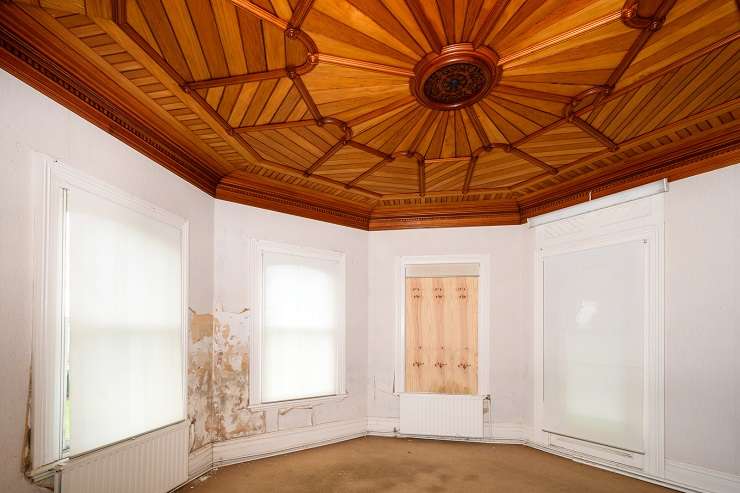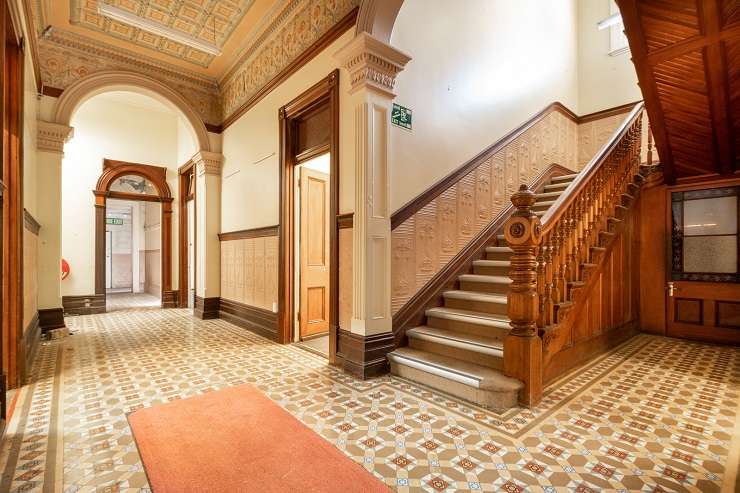The heritage mansion on the north-west fringe of Auckland being sold by New Zealand’s Defence Force on behalf of His Majesty King Charles III now has a price guide on it.
The 732sqm brick villa at 25-29 Clark Road, Hobsonville, is being marketed by Harcourts agents Graham Lewis and Sue Noonan as “an invitation to offers over $5.2m” with the deadline sale closing on March 25.
The Defence Force had put the former Royal New Zealand Air Force premises on the market in late 2022, without any price indication. The holdings, which include the house on a 1.9-hectare section, have a category 1 listing on the Historic Places Register, but with a CV of $16.58 million the property has failed to find a buyer over the past 18 months.
When approached by OneRoof, Lewis said he was unable to comment on the change in marketing tactic.
Start your property search
The Crown-owned property is held under the Public Works Act with the title in the name of the sovereign for defence purposes.
Read more:
- Dunedin’s secret castle for sale: How husband turned lifestyle block into medieval fortress
- From $400K to $1.825m: Sale of Grey Lynn do-up a victory for owners who bided their time
- Interest rate relief: Has the Government opened the floodgates to property investors?
Historical accounts show the Crown paid just £8000 for the property, known as Clark House, back when it was acquired in 1950. The RNZAF used the house as offices for Task Force Headquarters, even hosting a South East Asian Treaty Organisation conference in 1955 in the grand rooms, before moving out in 2016.
When the house was first put on the market in October 2022, Phil Gurnsey, general manager estate strategy for Defence told OneRoof that most recently it had been a medical unit, the rooms upstairs used as offices, the lower floor for reception and medical testing. An annex was added in 1967 to house a decompression chamber. He added at the time it was the only Hobsonville Defence land on the market.
Gurnsey was unable to say what other land was owned by the Crown around the area, including how much was disposed when the master-planned community at Hobsonville Point was developed in the early 2000s, but said his division disposes of properties no longer required for Defence purposes in accordance with standards and guidelines set out by Land Information New Zealand.
Lewis and Noonan say in their advertising that the property – which they call an “outstanding technological and archaeological example” – is a Historic Places category 1 building, completed in 1902, and “now needing restoration includes at least 10 very large living rooms and bedrooms, along with largely gutted kitchen and bathroom areas, an impressive central curved staircase, decorative feature tiles, stained glass windows, carved fire mantlepieces and a huge annex built in 1969.”

Clark House, used by the Defence Department as RANZF offices and medical facilities from 1950 to 2016, is now surrounded by subdivisions. Photo / Supplied

The grand rooms have hosted South East Asian Treaty Organisation meetings, as well as more prosaic offices. Photo / Supplied
The Italianate-style house was built by well-known English ceramics entrepreneur and pioneer Rice Owen Clark II as a showpiece for his company’s experimental hollow ceramic blocks made in the adjacent Limeburners Bay plant. When the Hobsonville clay ran out, the company moved to New Lynn, but the Clark family remained in the house until it was sold in 1950.
Later generations of the Clark family formed Crown Lynn Potteries which became Ceramco, a large public conglomerate, in the 1970s.
The 723sqm two-storeyed villa has iron-lace verandas, elaborate internal tiling, pressed metal and timber ceilings, dado panels and a grand staircase and fireplaces, although windows are boarded up in the now-empty building.
Large scale development sites are scarce in this part of Auckland, according to Bayleys agent Wesley Gerber, who specialises in development and subdivision zoning in the rapidly growing north-west region.
But, he said, buyers tend to be cautious about properties with a heritage listing.
“It depends on how big the heritage overlay is over the land, and what is left in terms of development for the remainder. You would model your numbers on what’s able [to be subdivided].
“Whether that’s acceptable to the seller is another story,” he told OneRoof.
He said that the repurposing of the old Hobsonville base into Hobsonville Point was a good example of how the master-planners had successfully integrated protected old buildings within new developments.
Gerber added that there was a shortage of greenfields sites around the rapidly growing region as proposed plan changes were constrained by lack of funding for infrastructure. Not enough land supply for large-scale builders could work in favour of the Clark Road site.

The house is a showcase of craftsmanship, with a grand staircase, Victorian mosaic tiles and stained glass windows. Photo / Supplied
“You could argue that Clark Road is a brownfield, not a greenfield, because it’s a very much urbanised area. We’re seeing a lot of demand [for that sort of land].”
Also helping the sale will be more confidence from developers.
Gerber said that after pausing new builds for the last year or two, developers were once again confident to re-start building as land prices, and building and civil works costs have stabilised and interest rate drops are signalled for next year.
“So we’re seeing an uptick in property that can be bought today ready to sell [finished homes] in two years when the market recovers,” he said, adding that this year buyers were ready to commit if vendors were prepared to meet market prices.
Harcourts agent Diego Traglia said that good quality new-build homes were still finding a market, while poor quality ones were suffering.
“There’s an oversupply of property that people don’t want. By that I mean an entry-level build, no landscaping, zero backyard, very small. There’s an oversupply and unfortunately it’s not clearing out.”
The sweet spot in the market, he said, was new buildings mixed into an older neighbourhood, nicely presented and landscaped. Homes with a price point under $1m were selling faster than $1m to $1.5m, he added.
“Those get eaten up very, very fast. There are two types of developers out there, the professional ones who have attention to detail, and then the others who just want to make something and sell it fast – in reality they end up on the market for a long time.”
Traglia said some developers who misjudged the market were in a lot of pain.
He estimated those who spent $1.5m on a property with an older house at the peak of the market, then another $100,000 or so on resource consents, were now unable to go ahead with their plans because building costs would add up to more than what they could sell the townhouses for.
“They’re hanging on by their fingernails as long as they could. There’s a lot of people trying to sell their problem to another person, but people don’t want to buy.”
However, Traglia said if a good developer could subdivide the Clark Road land, there was good demand for smart five-bedroom, three-bathroom houses on 300sqm plots.
“That would be a very desirable neighbourhood,” he said.
– 25-29 Clark Road, Hobsonville, Auckland, is seeking enquiries over $5.2m






































































